Aerodynamic design is a key factor for optimising the performance of EVs, it is a necessity to ensure that every thimble of output and charge from the battery can be squeezed out and sent to the road to ensure maximum driving range. And a slippery surface with lower wind-resistance can help achieve that objective.
An aerodynamic design can also help improve the appeal of the vehicle and increase the chances of it bringing in younger buyers. That is exactly what Volvo must be hoping for with the new C40 Recharge that is being launched early next week.
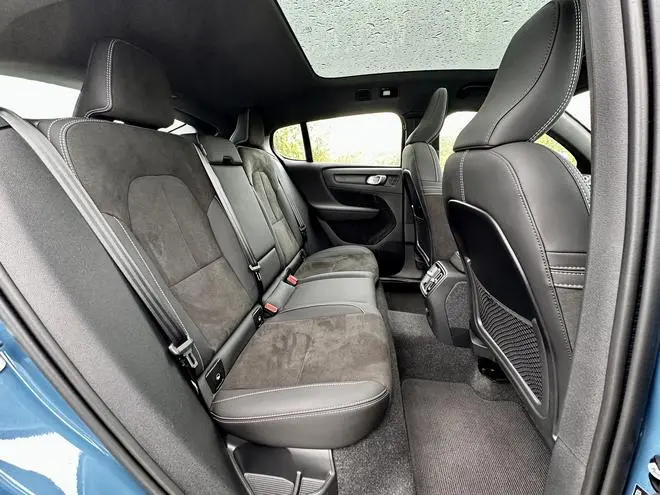
Design
Called just C40 in Sweden, Volvo’s home market, here it’ll be the new C40 Recharge and will possibly be faced with its biggest competitor in-house. The XC40 Recharge that the company launched last year, has already become one of every four cars that Volvo sells in India.
The Swedish brand is well on its way to becoming an EVs only brand in the future and the C40 Recharge is the next in line as part of its India strategy. The C40 Recharge is the sinuous, unique SUV-Coupe version of the XC40 Recharge. And despite some of the shared plastic panels in the cabin that are the vestiges of a fossil-fuel past, the C40 Recharge is a born-electric vehicle.
The design of this SUV-Coupe is different, but it still shares much of its front profile with the XC40 Recharge. Delivering the brand’s identity, the LED headlamps with the Thor-hammer light signature and the solid bonnet grille with the Volvo logo sash running across are the same. But the C40 Recharge gets Pixel lights, 84 of them, for its headlamps, and active light tech enables it to optimise light throw without dazzling other road users. Some changes to the C40’s front fender, compared to the XC40 Recharge, are the only other new bits.
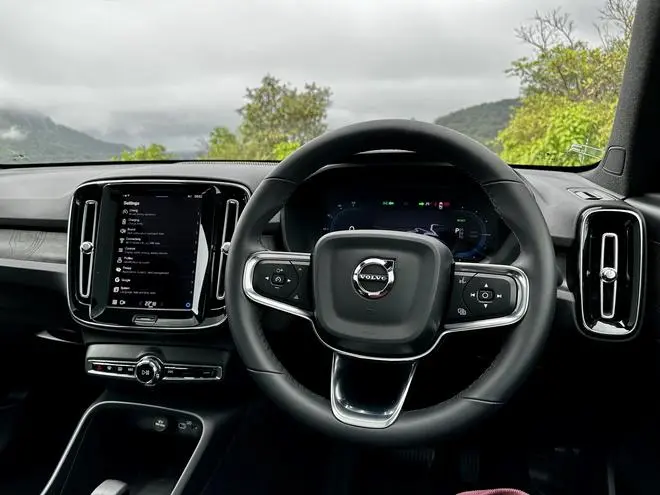
All the drama of the C40’s design is at the rear. The coupe body style means that the roofline gets a striking swoop downwards after the B-pillar. The roofline is a smooth brushstroke ending at the edge of the boot lid and offering a dramatic visual contrast between the body-styles below the waistline and above it - compact, yet strong SUV for the bottom half and a sporty coupe above it.
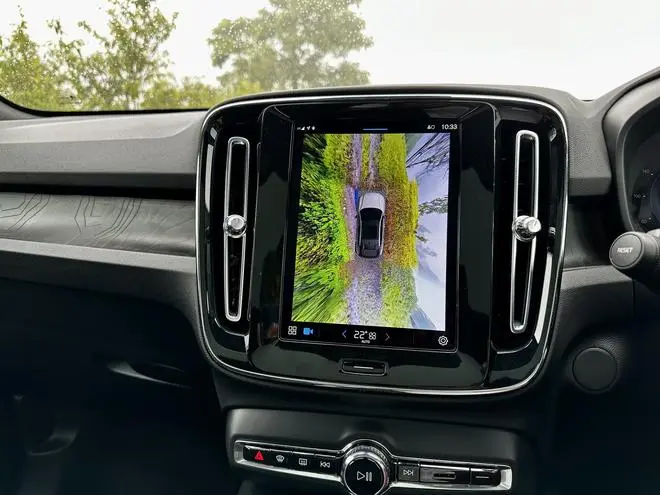
Adding more design appeal and enabling better aero performance, the C40 Recharge gets two spoilers one that sits atop the rear glass and the other, more conventional one, that adorns the boot lid. Volvo officials claim that the aero performance helps deliver a four per cent improvement in range and that the Pirelli low rolling-resistance tyres offer another eight per cent advantage.
The trademark Volvo tail-lamp design also gets a sportier makeover for the C40. The tail-lamps wrap around the edges of the C40’s haunches on either side and rise to the top of the rear glass. The LEDs also get a welcome sequence, the light equivalent of a jingle, every time the driver unlocks the vehicle. The 19-inch diamond-cut alloys look good and the side profile’s impact is also improved due to the black cladding that runs over and across the wheel arches. Overall, the exterior design is very appealing, even if familiar in places.

Cabin
The C40 Recharge’s interior is a bright, cheery place to be thanks to the amount of the light that streams in through the large windows and tinted panoramic sunroof. The cabin itself seems familiar because like the exterior design, there are several shared elements in the interior too between various models in Volvo’s portfolio. There is a sense of hierarchy that is evident in the way some features are sized or executed, but they sport a familiar design.
For example, the vertical centre stack vents for the aircon and the way they are integrated with the housing for the 9-inch infotainment screen. If you are looking for some EV-focused novelty in the way the cabin is kitted out, you’ll be disappointed. And some of you may feel that Volvo’s replication of interior design across models is getting a bit too predictable. But there are a few special bits in the C40 Recharge’s cabin like the 3D-printed panel on the dashboard that is meant to be topographical representation of the mountains in northern Sweden.
The panel is backlit with a soothing glow and transforms into an interesting panel at night. The sunroof gets infrared reflective coating and offers UV protection.
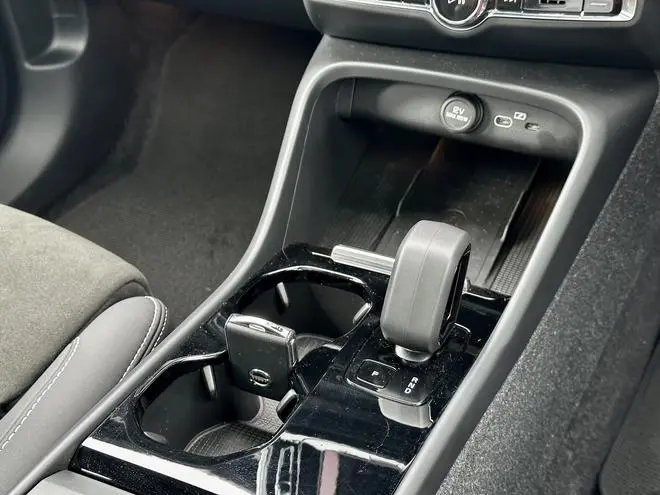
Given Volvo’s focus on adopting environment-friendly practices, it is not surprising to see a number of trim elements fashioned out of recycled materials in the C40. The carpet set is said to be made from recycling 71 plastic bottles, and the seats sport vegan leather. Some of the other key features in the Volvo C40 Recharge’s include the premium, 13-speaker Harman Kardon music system, a cabin air purifier with PM2.5 sensor, wireless phone charging, and a 12.3-inch digital instrument cluster.
The front seats are comfortable, the rear seat offers a fair amount of legroom and kneeroom, though the seat squabs themselves don’t offer the same level of comfort. Headroom at the rear is also good despite the SUV-coupe design’s sloping roofline. The portrait-oriented infotainment screen sports the familiar menu options and settings as seen in other Volvo models, with the addition of battery-related and ADAS vehicle display settings.
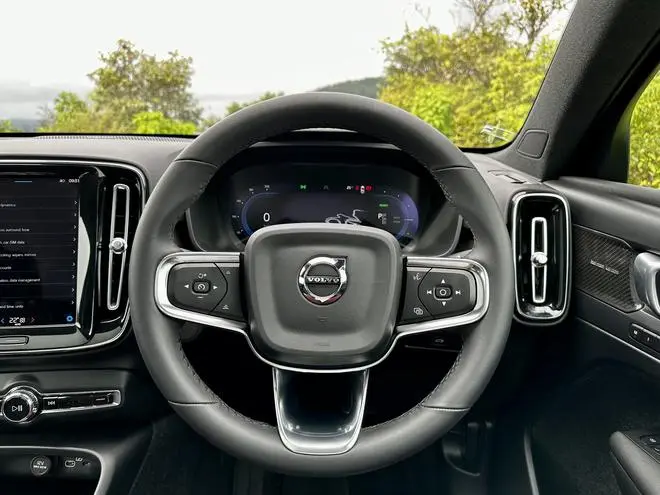
At 413-litres, the boot is smaller (by about 40-litres) compared to the XC40 Recharge. You’ll also have to deal with the space saver spare wheel that is strapped to the boot floor. The 11kW charging cable which is part of standard kit will take up much of the 31-litres of space offered by the frunk under the bonnet.
BEV performance
The C40 Recharge effectively offers the same Battery-Electric powertrain offered in the XC40 Recharge. But all the numbers are not identical. The C40 is also being offered only in its twin-motor, all-wheel drive avatar for Indian buyers (same as the XC40 Recharge). Other markets get a lower output single motor version too. The C40 Recharge Twin’s total power output is 408hp and peak torque is a massive 660Nm.
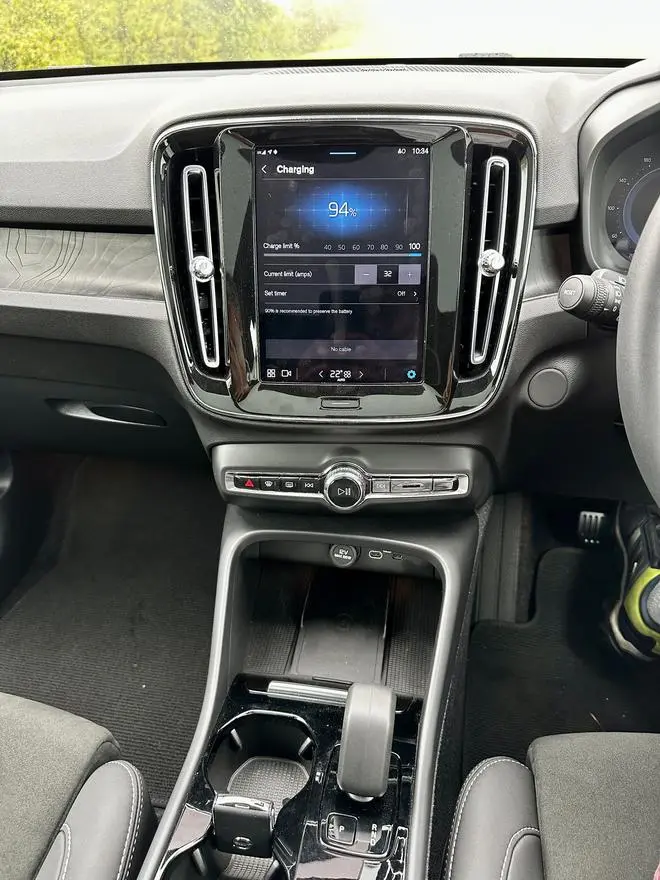
The battery pack is the same 78kWh capacity as in the XC40 Recharge but is said to be made up of cells that are more efficient and offer higher energy density. Unlike the XC40’s 50:50 split, the C40 Recharge gets a 40:60 distribution, and so, the two motors offer power outputs of 163hp and 245hp respectively for the front and rear. The battery pack has been encased in a safety cage and is located under the floor of the C40.
The battery can be charged using the 11kW AC charging cable provided (overnight top-up) or can be plugged into DC fast chargers upto 150kW capacity; the latter can deliver an 80 per cent charge from 10 per cent in 27 minutes. As for the driving range, the C40 Recharge manages to offer even more than the XC40 Recharge due to the higher density battery and the better aerodynamics.
The European WLTP range is 530kms, but the Indian cycle ICAT range is an even higher 683kms, that’s nearly a 20 per cent improvement over the XC40 Recharge.
The new C40 Recharge is blisteringly quick on the road. The claim about instant torque at the wheels for EVs and its effect on acceleration is best felt in an EV like this one. The C40 does the zero to 100kmph run in 4.7 seconds and even that number doesn’t quite convey the impact of the instant acceleration.
Flooring the pedal elicits a visceral, almost crushing response that pins me back into the seat. One of the USPs of the new C40 Recharge is its one-pedal driving ability with strong regenerative braking doing the job of decelerating the vehicle to a standstill. Yet, with this kind of performance being delivered at the wheel, I hardly had the urge to drive it like a chauffeur might.
The ride quality is good, and the suspension setting overall feels very similar to the XC40 Recharge. With its central weight distribution, the handling and ride both get a leg up. While the steering feels precise enough, there is not much feedback. My test mule’s low profile, low rolling resistance tyres offered enough grip even on a rainy day.
Bottom Line
Advanced driver assistance systems (ADAS) with Level 3 autonomous driving using five cameras, three radars and ultrasonic sensors is standard, and includes features like adaptive cruise control, rear cross traffic alert, lane keeping assist, blind spot monitoring and collision avoidance.
The new C40 Recharge is being offered only in one fully loaded trim variant. Expect prices to range from about ₹62 lakh to ₹65 lakh. Until the Skoda Enyaq EV makes it to our shores, the C40 Recharge could be one of the best looking EVs in the segment, and one that can also shock you with its segment-above on-road performance.




Comments
Comments have to be in English, and in full sentences. They cannot be abusive or personal. Please abide by our community guidelines for posting your comments.
We have migrated to a new commenting platform. If you are already a registered user of TheHindu Businessline and logged in, you may continue to engage with our articles. If you do not have an account please register and login to post comments. Users can access their older comments by logging into their accounts on Vuukle.